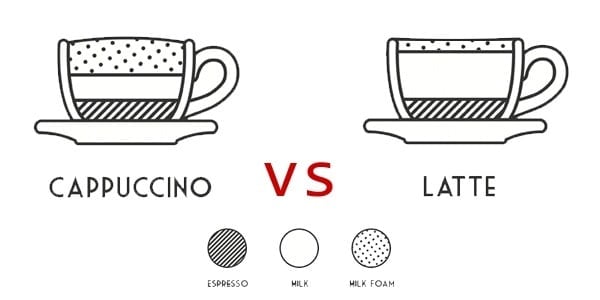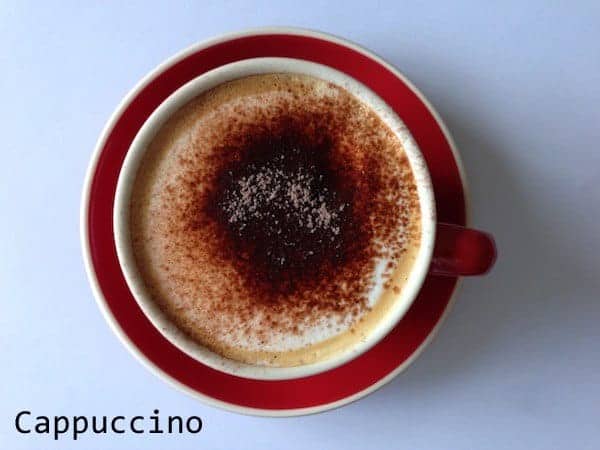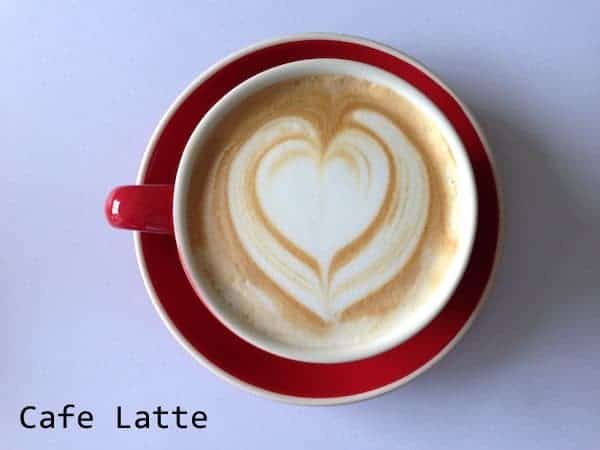One of the most common questions I get asked as a barista is, “what’s the difference between a cappuccino and latte — cappuccino vs latte.“
In practise they’re two very similar drinks, but there are a few key differences that set them apart. Today I’ll be providing a barista’s explanation on how they’re made.
Cappuccino vs Latte

As seen by the diagram above the main difference between a cappuccino vs latte (aka “cafe latte”) is the proportions of espresso, milk and milk foam in the beverage.
Traditionally a cappuccino has more foam and less milk compared to the latte. Also a cappuccino has chocolate powder dashed on top whereas the latte does not (some cafes choose not to dash on chocolate powder but more on this later).
In respect to their taste the two drinks are practically identical and made with the same machine. A cappuccino tastes slightly sweeter due to the chocolate powder on top, but it’s the texture that you’ll notice on consumption. As a cappuccino has more foam it tastes thicker and can be enjoyed by spooning out the foam. Whereas the the latte has less foam and goes down much smoother and faster.
Below you’ll find instructions on how to make a cappuccino vs latte. You’ll see from the photos the two coffees look very similar. But it’s what’s below the surface that counts.
How is a Cappuccino Made?

A cappuccino is made as follows:
- Extract one shot of espresso into a cup
- Pour steamed milk into the cup
- Pour 2-3 cm of milk foam into the cup
- Dash chocolate powder on top
(Or you can take a short-cut with a great cappuccino maker).
How is a Latte Made?

A latte is made as follows:
- Extract one shot of espresso into a cup
- Pour steamed milk to the cup
- Pour 1cm or a “finger width” of milk foam into the cup
- Latte art is optional
What are Lattes and Cappuccinos Served In?
One thing to note is that countries around the world serve their cappuccinos and lattes differently. For example in the images above both the latte and the cappuccino were served in a ceramic cup. This is the typical serving method in the United States.
However in Australia and New Zealand, a latte would normally be served in a tumbler glass. The drink is exactly the same, just the vessel is different due to local trends.
Does a Cappuccino Have Chocolate Powder On Top?
To dash chocolate powder or not to dash chocolate powder? That is the question. Well, it’s the question that causes the most debate surrounding how cappuccinos are made.
If you were to order a cappuccino in Italy you would not get chocolate on top. Whereas if you ordered a cappuccino in Australia, UK or New Zealand, you would get a good dash of chocolate powder. The United States varies from cafe to cafe on whether chocolate powder is used.
But why is there such a difference in opinion?
Well there’s two reasons.
The first is that there’s no universal standard or “rule book” on how a cappuccino should be made.
The second has to do with local trends once again. AKA making what consumers expect to find. Being from Australia I’ve always made my cappuccinos with chocolate on top. This is how every cafe does it down here in order to give greater differentiation between a latte and cappuccino. Whereas the consumers near you may have different expectations.
So should you or should you not dash chocolate powder?
The answer quite unsatisfactorily is “it depends on your local trends“. But I recommend making a cappuccino both with and without chocolate powder so you can compare the difference.
What Should You Order? Cappuccino vs Latte
If you’re a fan of chocolate and extra foam, a cappuccino is your beverage of choice. But if you enjoy your coffee with less foam and no chocolate, a latte is the way to go. Try each of them next time you visit a local cafe then let us know which one you prefer in the comments below.
P.S. Also let us know how you make your latte and cappuccino and where you’re from. Let’s see how the methods differ around the world!
Make sure to also check out our guide on latte vs mocha.


when i ordered a cap in italy (just outside milan), i would get a dash of chocolate powder about half the time – maybe because they knew I was american, but it seemed standard
Here in Bournemouth England it’s exactly how you have described x
i like latte over cappuccino any day, especially hazelnut latte. I feel cappuccino is too mild in taste whereas i prefer my coffee strong in taste.
Cappuccinos in italy have much more foam. Also it is not socially acceptable in Italy to drink milky coffees after lunchtime.
Here in Germany some traditional (old-fashioned) cafes still serve the cappuccino with chocolate powder on top. But the trend is to serve the cappuccino like a latte without chocolate just with more milk foam. And in some cafes it is considered good manner to ask whether you like chocolate on top or if you prefer your cap without it.
Since the cappuccino’s origin is Italy, doesn’t that imply that a cappuccino should not have chocolat on top?
Chocolate powder on cappuccino is a crime and should be severely punished by angry finger pointing and screams of horror!
If you need it that much, do it in private! Gaaaaah!
Yes, a crime, punishable by isolation in the cappuccino shop.
Need single tumbler size coffee and cappuccino maker. No froth needed.
Helpful article. I moved to Australia from USA and ordered a few cappuccino’s and they had chocolate on them so now I just order latte’s. Wherever I’ve lived in my life in US they ask you before putting chocolate on top.
I’m shocked everyone is focused on chocolate and milk foam when the topic is coffee.
The biggest difference is the amount of steamed milk. A latte is more mild and creamy. My father used to put a dash of coffee in my cup of milk and I could just taste the coffee. Yummy as a child.
The cappuccino has less steamed milk and thus you get a bolder bitter mouthful of roasted coffee. I believe it is even more essential to use a proper roasted espresso bean since you are tasting much more of the coffee.
I was raised on coffee milk and then moved on to latte in college and as an adult drink cappuccino. Yes the extra foam is nice but it’s the bold coffee under the foam that calls to me.
Shouldn’t this conversation be and the coffee?
Bruh yeah but that choc changes the dynamics so to me it’s Latte, Cappuccino and then Mocha……0,+1 & +2 in bittersweet and these affects whatever coffee we are discussing